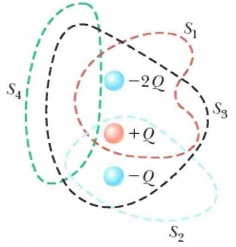Assignment:
1. A 7.52 nC charge is located 1.70 m from a 3.90 nC point charge.
(a) Find the magnitude of the electrostatic force that one charge exerts on the other.
(b) Is the force attractive or repulsive?
2. A charged particle A exerts a force of 2.50 pN to the right on charged particle B when the particles are 12.0 mm apart. Particle B moves straight away from A to make the distance between them 18.1 mm. What vector force does particle B then exert on A?
3. A small sphere of mass m = g and charge q1 = 27 nC is attached to the end of a string and hangs vertically as in the figure. A second charge of equal mass and charge q2 = -58.0 nC is located below the first charge a distance d = 2.00 cm below the first charge as in the figure.
(a) Find the tension in the string.
(b) If the string can withstand a maximum tension of 0.180 N, what is the smallest value d can have before the string breaks?
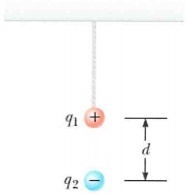
4. A small sphere of charge q1 = 0.792 pC hangs from the end of a spring as in figure (a). When another small sphere of charge q2 = -0.558 μC is held beneath the first sphere as in figure (b), the spring stretches by d = 3.33 cm from its original length and reaches a new equilibrium position with a separation between the charges of r = 4.90 cm. What is the force constant of the spring?
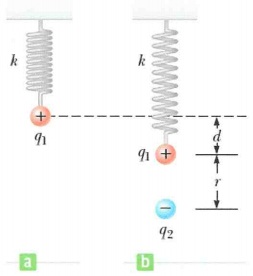
5. A small object of mass 3.74 g and charge -16.7 μC is suspended motionless above the ground when immersed in a uniform electric field perpendicular to the ground. What are the magnitude and direction of the electric field?
6. A small block of mass m and charge Q is placed on an insulated, frictionless, inclined plane of angle θ as in the figure below. An electric field is applied parallel to the incline.
(a) Find an expression for the magnitude of the electric field that enables the block to remain at rest. (Use any variable or symbol stated above along with the following as necessary: g for the acceleration due gravity.)
(b) If m = 5.91 g, Q = -6.93 μC, and θ = 27.3°, determine the magnitude and the direction of the electric field that enables the block to remain at rest on the incline.
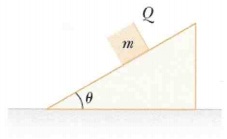
7. (a) Three point charges, A = 1.90 μC, B = 6.90 μC, and C = -4.70 μC, are located at the corners of an equilateral triangle as in the figure above. Find the magnitude and direction of the electric field at the position of the 1.90 μC charge.
(b) How would the electric field at that point be affected if the charge there were doubled?
(c) Would the magnitude of the electric force be affected?
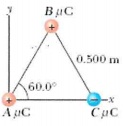
8. The figure below shows the electric field lines for two point charges separated by a small distance.
(a) Determine the ratio?
(b) What are the sign of q1 and q2?
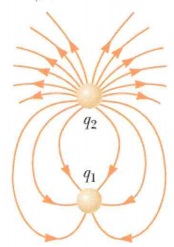
9. A uniform electric field of magnitude E = 400 N/C makes an angle of θ = 63.0° with a plane surface of area A = 3.40 m2 as in the figure below. Find the electric flux through this surface.
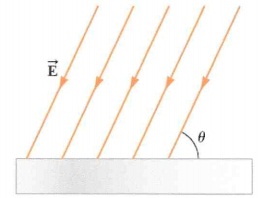
10. Four closed surfaces, S1 through S4, together with the charges -2Q, Q, and -Q are sketched in the figure below. (The colored lines are the intersections of the surfaces with the page.) Find the electric flux through each surface. (Use the following as necessary: εo and Q).
